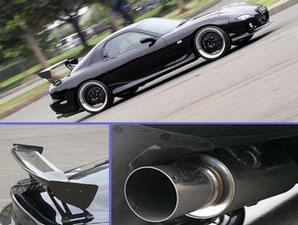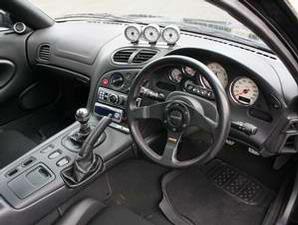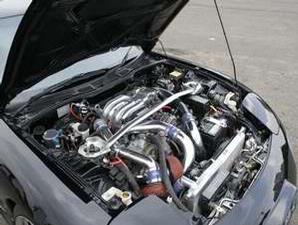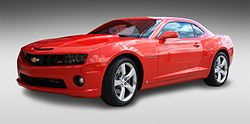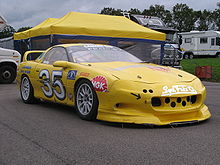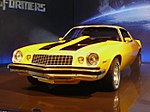Honda Civic Type R
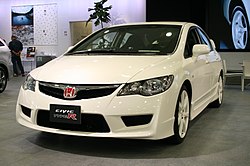 | |
| Manufacturer | Honda |
|---|---|
| Production | 1997–2010 |
| Class | sport compact |
| Body style | 3-door hatchback, 4-door sedan |
| Layout | FF layout |
| Related | Honda Civic Si |
Contents[hide] |
[edit] 1st generation (EK9 chassis)
 | |
| Production | 1996-2000 |
|---|---|
| Body style | 3-door hatchback |
| Layout | FF layout |
| Engine | 1.6 L 185HP B16B I4 |
| Transmission | 5-speed manual |
The first Civic to receive the Type R badge was introduced in 1998 as the EK9. The EK9 shared many characteristics with the Integra Type R DC2 such as omission of sound deadening and other weight-reduction measures, a hand-ported B16B engine, front helical limited-slip differential and close ratio gearbox etc.. The B16B engine boasted one of the highest power output per litre of all time for an NA engine with 185 PS (136 kW; 182 hp) from a 1.6L. For the first time, a strategically seam welded monocoque chassis was used to improve chassis rigidity. The interior featured red Recaro seats,red Recaro door cards and red Recaro floor mat, a titanium shift knob and a Momo steering wheel. In 1999 the Type Rx was introduced featuring a CD player, body colored retractable electric door mirrors, power windows, auto air conditioning, key-less entry unlock system, aluminum sports pedals, and a carbon type center panel. The SiR badge from the previous 2 generations was ceded to the EK4 Civic as a mainstream sedan and hatchback which was sold in huge numbers across the globe due to its relatively low cost, practicality and everyday usable street performance/drivability.
[edit] 2nd generation (EP3 chassis)
 | |
| Production | 2001-2005 |
|---|---|
| Body style | 3-door hatchback |
| Layout | FF layout |
| Engine | 2.0 L K20A I4 |
| Transmission | 6-speed manual |
The EDM EP3 Civic Type R was much acclaimed by motoring journalists across the UK, winning 'Hot Hatch of the Year' awards more than once from Top Gear, Fifth Gear and What Car?. The Civic Type R became a popular alternative for mainstream drivers clocking huge sales numbers. The 2001 release of this CTR (Civic Type R), as it is commonly referred to, also indicated Honda's return to Formula One after almost 10 years as an engine supplier to the Jordan and BAR teams - this eventually led to the full-fledged comeback as a dedicated F1 works team in 2005 with Honda gaining full ownership of British American Racing.
2004 saw this successful CTR updated with many improvements - revised EPS with quicker steering, revised suspension settings, projector headlamps (JDM came equipped with halogens only while the EDM came with an option for HIDs with leveling motors), lighter clutch and flywheel assembly etc.; based on Honda literature, this facelifted (FL) model was targeted at addressing customers' and critics' feedback such as understeer on the limit (due to the front Macpherson strut setup), numb steering response and lack of low end torque.
Performance (all figures are manufacturer claims)
0-60 mph in 6.4/6.4 seconds (JDM/EDM pre-FL), 6.2/6.4 secs (JDM/EDM FL) 0-100 mph in 15.1/16 secs (JDM/EDM FL) Top speed 112 mph (180 km/h) and 146 mph (235 km/h) (JDM/EDM both)
[edit] 30th Anniversary Special Edition
In 2003 Honda decided to celebrate 30 years of producing the Civic by offering a special edition 30th Anniversary Type-R for the EDM. The special edition features special red sports seats from world renowned seat maker Recaro, air conditioning, leather MOMO steering wheel, red carpets and door linings and privacy glass on the rear windows. 30th Anniversary models were available in Nighthawk Black, Satin Silver and Milano Red. Only 300 of these models were produced, 100 in each of the 3 colours.[edit] Premier Special Edition
In 2005 Honda introduced the Premier edition which had Recaro Trendline seats (similar to those found in the Anniversary Edition, only in red and black rather than all red), a darker shade of fabric on the rear seat centre sections, a Momo Steering Wheel, Red Carpet, "Type R" embossed into the front brake calipers and privacy glass on the rear windows. These were available in Milano Red, Nighthawk Black, Cosmic Grey and Satin Silver.[edit] C Package
In 2004 Honda introduced the "C Package" option (¥330,000 JPY) to Japan's Civic Type R lineup which included an additional color, Satin Silver Metallic, HID lighting, rear privacy glass, automatic air conditioner and outside air temperature sensor.[1][edit] 3rd generation (FD2 & FN2 chassis)
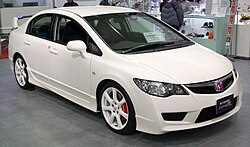 | |
| Production | 2007-2010 |
|---|---|
| Body style | 4-door sedan (FD2) 3-door hatchback (FN2) |
| Layout | FF layout |
| Engine | 2.0 L K20A I4 (FD2) 2.0 L K20Z4 I4 (FN2) |
| Transmission | 6-speed manual |
FD2 chassis (Asian version)
The Japanese market Civic Type R (FD2) went on sale on March 30, 2007. For the first time, the JDM Civic was sold as a four door sports sedan rather than a three door hot hatch. Using the Japanese market four-door sedan as a base model meaning the new Type R is now bigger, wider and heavier. More importantly, the wheelbase has grown from 2,570 mm (101.2 in) to 2,700 mm (106.3 in), giving the FD2R a more stable stance in high speed cornering. The new Japanese model's engine output is higher than the European version's, with 225 PS (165 kW; 222 hp) being developed at 8,400 rpm and 215 N·m (159 lb·ft) of torque peaking at 6,100 rpm (versus 201 PS (148 kW; 198 hp) at 7,800 rpm and 193 N·m (142 lb·ft) at 5,600 rpm for the European model). The base engine itself is borrowed from the Accord Euro R CL7 with its longer intake manifold. Changes have been made to the block in terms of mounting points for ancillary parts making it different from previous K20A. New technology such as Drive By Wire throttle and porting of the intake valve ports using techniques from the NSX are implemented. Honda says mid-range is increased by 10 PS (7 kW; 10 hp). Drive is fed through a close ratio six speed gearbox, and a helical limited slip differential is fitted as standard. The front brake discs increased from the DC5R's 300 mm (11.8 in) to 320 mm (12.6 in) are fitted with four pot Brembo calipers. Tire size are now 225/40 R18 Bridgestone Potenza RE070.Honda claims the body is 50% more rigid than the previous Japan-only DC5 Integra Type R, and the new model features an independent rear suspension rather than the torsion beam configuration used on the latest European Civic Type-R.[2] To save weight, aluminum is used extensively and bonded with adhesive instead of welded. Though the body is larger and more rigid than JDM Integra Type R, it is only 1.8 kg (4 lb) heavier.[3]
Exterior wise, the front bumper is different from the standard Civic designed aerodynamically. The rear bumper features a diffuser built into the bumper and completing the aero package with a huge rear wing. Inside, the trademark black and red bucket seats are no longer made by Recaro as with previous versions, but designed in house by Honda. Also gone is the Momo made steering wheel, instead replaced by a Honda made version. The familiar red-on-black colour scheme or black-on-black scheme is offered on the Championship White version and Super Platinum Metallic Silver versions while a black-on-black scheme with red stitching is for the Vivid Blue Pearl only.
In October 2008, the Civic received a minor face lift. The standard and hybrid versions now had the same front bumper as the Type R while a redesigned tail lamps changes the round insets into octagons. The Type R also received new available colours, with Premium White Pearl, Premium Deep Violet Pearl and Crystal Black Pearl being added and Vivid Blue Pearl being dropped.
In back to back tests the FD2 Type-R was on average 1 second quicker than the (DC5) Integra Type-R at the Tsukuba Circuit and four seconds faster at the longerSuzuka.[3]
In a back to back test on the United Kingdom TV program 5th Gear, the FD2 Type-R was three seconds quicker than the equivalent FN2 UK version around Castle Combe Circuit in the wet.[4]
The FD2 Civic Type R was officially launched in the Malaysian market on August the 2nd 2007. It was the first time that any Type R JDM model was launched outside of Japan.
The FD2 Civic Type R ceased production in August 2010 because of failing to meet upcoming emission requirement. Following the previous success of introducing the FN2 Civic Type R from Europe in 2009, another batch of FN2 Type R with minor update is available in fall 2010.[5] The FN2 Type R has 197 hp (147 kW) vs the 225 hp (168 kW) output in the FD2 Type R.[6] The JDM Civic Type R will be replaced by a new model when the all-new JDM Civic arrives in late 2012.
Civic Mugen RR (Honda ABA-FD2)
In addition to Civic Type R, 300 Honda Civic Mugen RR cars in red only had also been produced for Japanese market, which reduced weight to 1,255 kg (2,770 lb) using CFRP bumpers and aluminum for the bonnet. The engine is rated 240 PS (180 kW; 240 hp) at 8,000 rpm and 218 N·m (161 lb·ft) torque at 7,000 rpm achieved through Mugen parts such as camshafts, exhaust system and ECU. Other exclusive items that make this a collectors item are Recaro SP-X seats and other Mugen items inside while special Mugen wheels equipped as standard. This version cost 4,777,500 yen (4,550,000+tax) ($38,750 USD) and went on sale on Sept 13 2007.[7]Mugen also debuted Civic Type-RR Experimental Spec concept car in Tokyo Auto Salon, which features 2157 cc K20A engine rated 260 PS (190 kW; 260 hp) and 237 N·m (175 lb·ft) of torque. Weight is further reduced using aluminum hood (4.6 kg (10 lb)), as well as the new titanium exhaust system (7.6 kg (17 lb)). Interior was replaced with more carbon fiber parts. The car also features Intelligent-Tire Condition Monitoring System (i-TCMS) and Recaro seats.[8]
The concept was later called Honda Civic Mugen RR Advanced Concept during 2009 Tokyo Auto Salon, which has the weight of 1,095 kg (2,414 lb).[9] Brake disc was increased to 340 mm (13.4 in) diameter (320 mm (12.6 in) in Type R/RR).[10]
Civic Mugen RC (2008-)
A race version called Honda Civic Mugen RC has also been produced, designed for the 2008 Honda Exciting Cup Civic One-Make Race-Civic Series.[11] The engine is the stock K20A engine from FD2 Honda Civic Type R. It comes with following models:- BASIC: 6,247,500 yen (5,950,000+tax).
- STANDARD: 7,192,500 yen (6,850,000+tax). It adds racing wheel package (Mugen RC 18 inch wheel with Yokohama tire), brake package (front+rear brake pads), seat and steering (Recaro bucket seat, seat rail, steering wheel with box, TAKATA harness), carbon inner part option A (carbon fibre right floor cover panel, footrest, door lining) over BASIC.
- COMPLETE: 7,822,500 yen (7,450,000+tax). It adds carbon inner part option B (carbon fibre console box, left floor cover panel, centre pillar cover), engine package (engine rebalancing and calibration)[12]
FN2 chassis (European version)
The European market Civic Type R is offered only as a three door hatch back and uses a different chassis and internal layout (notably tank placement below the driver's seat), which will serve as base for the next European Jazz. The rear suspension formerly a double wishbone set up has been changed to a less complex torsion beam axle. The drive train is largely the same as the out going model offering 201 PS (148 kW; 198 hp) at 7,500 rpm and 193 N·m (142 lb·ft) of torque at 5,600 rpm. It runs on 225/40 R18 Y88 Bridgestone Potenza RE050A tyres, while optional 19" Rage alloys run on Yokohama Advan Sport 225/35 ZR19 88Y tyres. The car has a curb weight of 1,267 kg (2,790 lb).Versions
Type R GT includes, dual zone climate control (Left:right independent), rain sensing windscreen wipers, refrigerated glove box, automatic headlights with dusk sensor, front fog lights, power folding door mirrors, cruise control, front and rear curtain airbags. It is finished in the same three colours as the standard FN2, and a new addition the range, deep sapphire blue pearl. As often, names and trims vary even within domain markets down to local ones, and a Heritage version replaces GT version in some of them, adding Xenon/HID lights to the mix. The topping Heritage Navi version adds Bluetooth telephone system and voice recognition DVD satellite navigation. A more radical version dubbed Race differs from the Heritage by removing components (incl. HID, AC, fog lights, audio system, sound proofing, some airbags) to reduce weight as much as 40 kg (88 lb). Finally, together with the 2009 revision to all 8th gen. EDM Civic variants (adding for example a USB iPod-compatible plug to the audio system), a special edition called Championship White comes in the eponyme Honda color, with the same alloys only with matching white color, 18" wheels (19" white Rage optional). This edition adds an exclusive limited slip differential to a Heritage trim level, which Honda touted at Paris Motor Show as helping the car shave off more than a second to its undisclosed Tsukuba lap time. In addition models made from the 1st March 2010 have LSD fitted as standard.Production of the current generation of the Civic Type R hot hatch for the European market finished in October 2010. The car’s high-revving 2.0-litre VTEC engine is to blame, as it does not meet forthcoming Euro V emissions regulations. Instead of reengineering the unit the meet the stricter standards, which come into force for all new cars in January 2011, the UK market Type R will be axed and replaced by a new model when the all-new Civic arrives in late 2011. Over 12,000 Civic Type Rs have been sold in the UK since January 2007, and although the last UK cars will be sold by December, Honda’s Swindon plant will continue to build the car for the Australian, Middle Eastern, and South African markets. It is also exported to Japan and marketed as Civic Type-R EURO in limited edition in fall 2010, following a successful run in November 2009.[14] According to Autocar, Euro V emission requirement also caused the demise of Alfa Brera with 3.2 V6, Ford Focus ST, Mazda RX-8 and the VW Group’s 5.0 V10 turbodiesel.[15]




